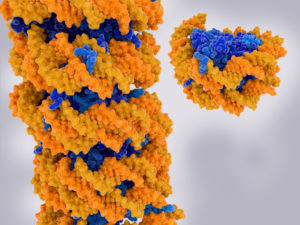
BMC Ecology and Evolution – Seeing through sedimented waters: environmental DNA reduces the phantom diversity of sharks and rays in turbid marine habitats

Sedimentation of seawater, coupled with elusive behaviour, can make it difficult for ecologists to monitor threatened or elusive species. However, with the development of new molecular technologies, researchers can find more than the eye can see using DNA found within environmental samples.
In a recent study published in BMC Ecology and Evolution, Ip and colleagues applied environmental DNA (eDNA) technology on seawater to detect shark and ray species in sedimented urban reef environments off Singapore. Historic reports documented a much higher diversity of shark and ray species compared to recent sightings. Therefore, the researchers asked whether local extinction of species had occurred or whether they have become too rare to be detected by traditional visual survey methods. Using eDNA from seawater, the researchers detected twice the number shark and ray species living off the coast of Singapore compared to those typically sighted within the last 20 years and were excited to discover two potentially new species.
In the face of global change, greater knowledge of the planet’s past and present ecosystems is more important than ever to manage biodiversity loss and set conservation priorities. This study is an excellent example of how advances in environmental DNA technologies is helping us meet this need for knowledge. To learn more about the promise of eDNA technology, please visit BMC Ecology and Evolution’s new Collection of articles on the topic, which is open to submissions <https://www.biomedcentral.com/collections/aedre>.
BMC Health Services Research: The impact of the COVID-19 pandemic on patterns of attendance at emergency departments in two large London hospitals: an observational study

Hospitals throughout England adapted to tackle the increased demand caused by the COVID-19 pandemic. First, the UK’s National Health Service performed an unprecedented re-arrangement of resources, including postponing non-urgent procedures and providing video consultations. In March 2020, the UK government then introduced a series of interventions, such as social distancing and instructing people to stay at home under national lockdowns.
However, the impact of these measures introduced to cope with the COVID-19 pandemic on emergency department (ED) visits in England is relatively unknown, particularly for non-COVID-19 related emergencies. Therefore, Vollmer and colleagues performed an observational study of ED attendances at the Imperial College Healthcare NHS Trust (ICHNT) in London to address this need for knowledge.
After the UK government imposed the first national lockdown from March 12, 2020, to May 31 2020, ED attendances at ICHT dropped by 35%, reflecting broader trends across England. This fall in admissions was mainly amongst those younger than 65 years old who arrived by their own means. ED visits by patients without COVID-19 after March 12, 2020, decreased by 48% and no significant change in hospitalisation outcome was observed for these patients. The extent to which these findings relate to avoidance behaviours due to concerns around coronavirus compared to those seeking alternative emergency health services remains unknown.
BMC Research Notes: ssvQC: an integrated CUT&RUN quality control workflow for histone modifications and transcription factors

All the cells within your body contain the same DNA, but each cell type behaves differently. Proteins, including transcription factors and histones, dictate cell identity by binding to DNA to regulate gene expression. Changes in DNA-protein binding, which control gene activity, underlie development and disease. Therefore, it is important for researchers to investigate specific DNA-protein interactions.
Traditionally, a technique called chromatin immunoprecipitation (ChIP) is used to achieve this goal. However, ChIP has several flaws, which led Skene and Henikoff to develop a new technique named CUT&RUN (Cleavage Under Targets and Release Using Nuclease).
In CUT&RUN, targeted DNA-protein complexes are isolated directly from the cell nucleus rather than following a precipitation step. As in ChIP, to perform CUT&RUN, a specific antibody is used to identify the DNA-binding protein of interest. However, in CUT&RUN, an enzyme that recognises the protein-antibody interaction is used to cut out distinct protein-DNA complexes, which can be isolated and sequenced. Therefore, CUT&RUN permits genomic mapping of DNA-protein interactions in much higher resolution using far fewer cells compared to ChIP.
Due to technical difficulties, it is not always feasible to use the CUT&RUN technique on fresh cells. Therefore, in BMC Research Notes, Boyd and colleagues evaluate how this new method performs using frozen cells. Boyd and colleagues compared a workflow for CUT&RUN with fresh and frozen samples and present an R package named ssvQC for quality control and comparison of data quality derived from this technique. The researchers find that frozen samples serve as a good starting point for performing CUT&RUN for a histone mark (H3K4me3) and a transcription factor (Ikaros).
BMC Pulmonary Medicine: Cough hypersensitivity in patients with metabolic syndrome: a clinical finding and its possible mechanisms

Cough hypersensitivity is characterised by troublesome coughing triggered by low levels of thermal, mechanical or chemical exposure. For many years, there was no term to describe such coughs with no apparent clinical explanation but this condition has now been named cough hypersensitivity syndrome, giving patients a reassuring and common diagnosis. A better understanding of the risk factors and pathophysiological mechanisms underlying cough hypersensitivity is needed to identify novel targets to manage the condition.
In the linked paper, Cheng et al. investigate cough induced by capsaicin – a chemical irritant derived from chilli peppers. The researchers compared patients with metabolic syndrome with healthy controls. Metabolic syndrome is the medical term given to patients suffering from a combination of diabetes, high blood pressure and obesity. Interestingly, participants with metabolic syndrome were more sensitive to capsaicin-induced cough compared to controls. The researchers further demonstrate that increased capsaicin-induced cough sensitivity in metabolic syndrome patients is closely related to sleep apnea and gastroesophageal reflux and speculate that airway inflammation may play a role in the pathogenesis of increased capsaicin-induced cough sensitivity.
BMC Complementary Medicine and Therapies – Headache and migraine clinical practice guidelines: a systematic review and assessment of complementary and alternative medicine recommendations

Headaches, including migraines, are one of the most common disorders worldwide. According to the World Health Organisation, almost half the adult population have suffered from a headache at least once within the last year. Many complementary and alternative medicines (CAMs) have been reported to help treat and manage headache disorders, but do they actually have a clinically beneficial effect?
In BMC Complementary Medicine and Therapies, researchers investigate the quantity and quality of CAMs in the context of headache disorders according to clinical practice guidelines (CPGs). CPGs describe statements used to assist practitioner decisions about how to care for people with specific conditions. Ng and Hanna searched literature published between 2009 and 2020 to identify CPGs for treating and managing headache and migraine disorders.
Out of 486 unique search results for terms describing headache disorders, 21 search results containing CPGs were eligible and quality assessed. Fifteen of these CPGs mentioned CAM, of which 13 CPGs made CAM recommendations. These findings could help improve the dialogue between patients and healthcare professionals regarding using CAM therapies to treat/ manage headache and migraine disorders.
Comments